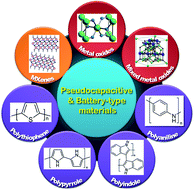Advances in pseudocapacitive and battery-like electrode materials for high performance supercapacitors
Abstract
Supercapacitors are energy storage devices with unique characteristics, and together with batteries have generated a significant research effort, with various types of electrode materials having been developed over the last few years. Current trends for this application have been gradually shifting towards pseudocapacitive/battery-like materials. When compared to electric double-layer capacitors, pseudocapacitive/battery-type materials have a decisive advantage, since they are usually able to deliver improved energy density. Furthermore, these materials can undergo reversible electrochemical reactions within a very short period of time without compromising their high charge storage capacity. In this article, we systematically survey the current state of the art regarding the fabrication and electrochemical performance of the most promising classes of pseudocapacitive/battery-type electrode materials for supercapacitors. The text covers metal oxides, mixed metal oxides, conducting polymers, and MXenes. Closing the article, some of the outstanding problems for increasing the performance of SCs are discussed, and future research directions are suggested.

- This article is part of the themed collection: 2022 Journal of Materials Chemistry A Most Popular Articles


 Please wait while we load your content...
Please wait while we load your content...